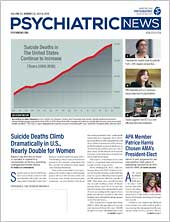Adolescence has long been known as a time of vulnerability for the start of mental disorders and substance use, yet not enough is known about normal brain development and its variations. To fill that gap, a collaborative federal program is starting to take a comprehensive look at young Americans.
The Adolescent Brain Cognitive Development (ABCD) Study is recruiting 11,500 young people aged 9 and 10 to collect physical, psychological, academic, demographic, and neuroimaging data to chart their development through their teenage years. The study will follow them up to age 21 and catalog the influence of genetic, environmental, and behavioral factors. Participants will get comprehensive assessments at baseline, with biennial follow-ups and additional phone or web contacts in between.
The study results will help develop national standards for brain development and the factors influencing that process, said Terry Jernigan, Ph.D., a professor of cognitive science, psychiatry, and radiology and director of the Center for Human Development at the University of California, San Diego (UCSD), in a symposium at APA’s 2018 Annual Meeting in New York.
The moment for such a study has arrived for converging reasons, said Jernigan. For one thing, there is a growing appreciation of the complexities of the adolescent brain’s development trajectories. Substance use patterns are changing with the opioid crisis and the ongoing legalization of marijuana laws, so both clinicians and policymakers need the information the study will provide. In addition, safe, noninvasive neuroimaging technology using functional magnetic resonance imaging has matured, affordable genotyping has arrived, and novel assessment techniques (like mobile devices or wearables) are now available.
“This study could not have been done even 20 years ago,” said Martin Stein, M.D., a professor emeritus of pediatrics at UCSD who specializes in developmental behavioral pediatrics, in an interview. Stein is not involved with the ABCD Study. “The convergence of MRI, functional MRI, sophisticated neuropsychological testing, and computer technology opens up new possibilities.”
As of May 6, 9,167 children had been recruited through schools, an approach intended to increase acceptance and retention. Large numbers are needed to make the research more comprehensive and permit the useful study of subgroups, said Hugh Garavan, Ph.D., a professor of psychiatry and psychology at the University of Vermont in Burlington and one of the study’s 39 principal investigators.
“A large cohort allows us to build in replication, detect small effects, and disentangle confounders like race and socioeconomic status,” said Garavan. “We can embrace variation and purposefully sample populations often excluded [from such studies].”
Recruiting children from low educational and socioeconomic backgrounds was going slower than expected but was largely on target, he said. “Initial analyses reveal substantial inter-individual variation and have set the stage for tracking differences in developmental trajectories on both risk and resilience factors.”
Some early results of the study provide insights into the world of young people, said investigator Mary Heitzig, Ph.D., an associate professor of psychiatry at the University of Michigan. She analyzed responses to questions about whether the children had heard of drugs, alcohol, or tobacco and if they had ever used them.
A majority had heard of substance categories, boys more than girls. About 24 percent had sipped alcohol, but only 1 percent had downed a full drink, and just 0.6 percent had puffed a cigarette.About 95 percent said they had no peers who used drugs, Heitzig reported.
“In general, most 9- and 10-year olds can be considered substance-naïve, but substance use is around them and they are aware of it,” she said. “Because drug exposure is minimal in this group, we will be able to to characterize youth before the onset of significant substance use.”
Another analysis of psychotic-like experiences among the first 4,500 children in the study confirmed a lack of variance based on race, ethnicity, or gender, as well as associations with family history of psychotic disorder, child-rated internalizing symptoms, cognitive impairment, and predicted differences in brain volume, reported Deanna Barch, Ph.D., a professor of psychiatry and chair of psychological and brain sciences at Washington University in St. Louis.
The ABCD Study was initiated by the NIH Collaboration on Addiction, led by the National Institute on Alcohol Abuse and Alcoholism (NIDA) and the National Cancer Institute, said Gayatri Dowling, Ph.D., director of the ABCD Project at NIDA. The study now includes several other NIH institutes, as well as the Centers for Disease Control and Prevention, the National Institute of Justice, and the National Endowment for the Arts. Around the country, 21 research sites will carry out the actual work of the study, coordinated by UCSD.
“Hopefully, ABCD will teach us something about the evolution of cognitive and behavioral disabilities in children and their early antecedents,” said Stein. “This will conceivably give us information on if and when early interventions can help these young people—once we have interventions.”
Project leaders have tried to learn lessons from the ill-starred National Children’s Study, which sought to recruit 100,000 children for a long-term study. The ABCD Study is deliberately one-tenth the size and built from the ground up through the consortium rather than from the top down, said Dowling.
Finally, use of the data generated by the study will not be limited to the principal investigators. An Open Science model will allow other qualified researchers at NIH-approved institutions to make use of the results and multiply their impact, said Dowling. ■

